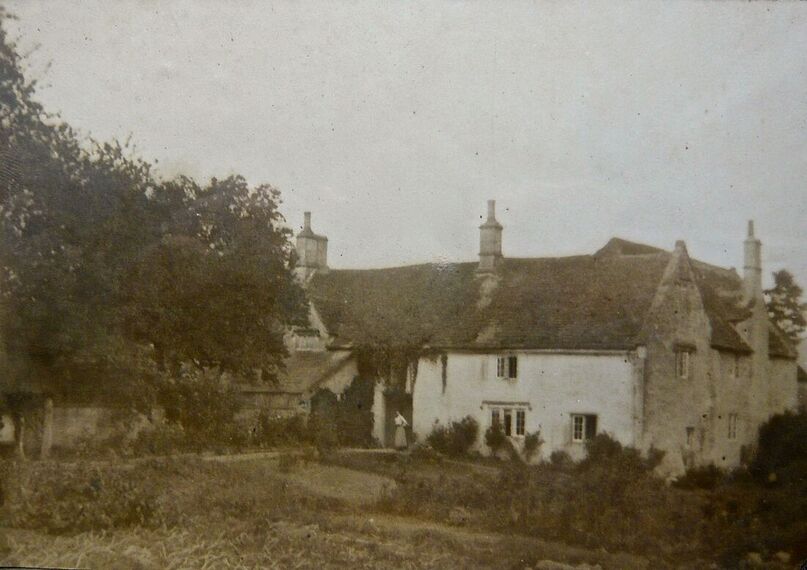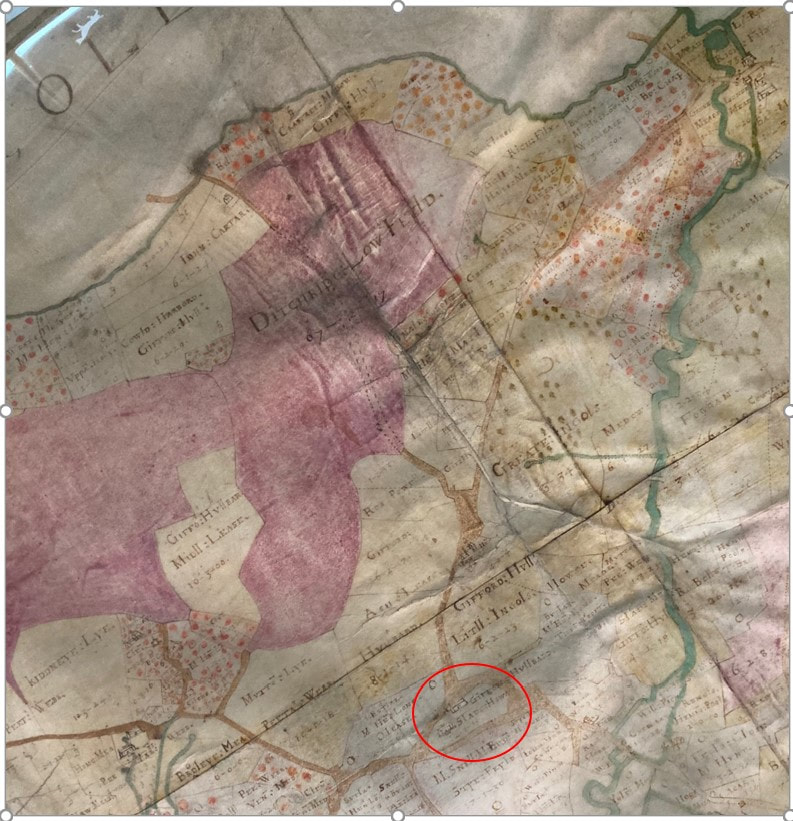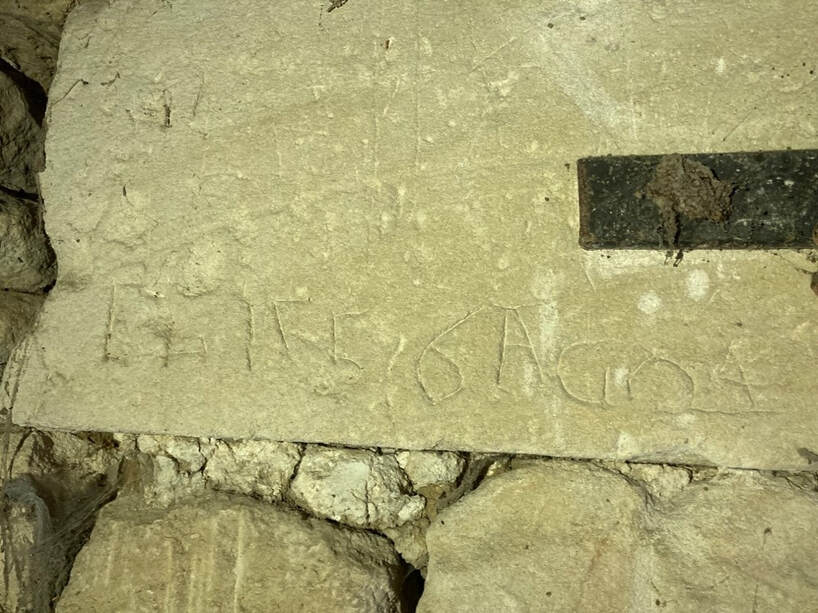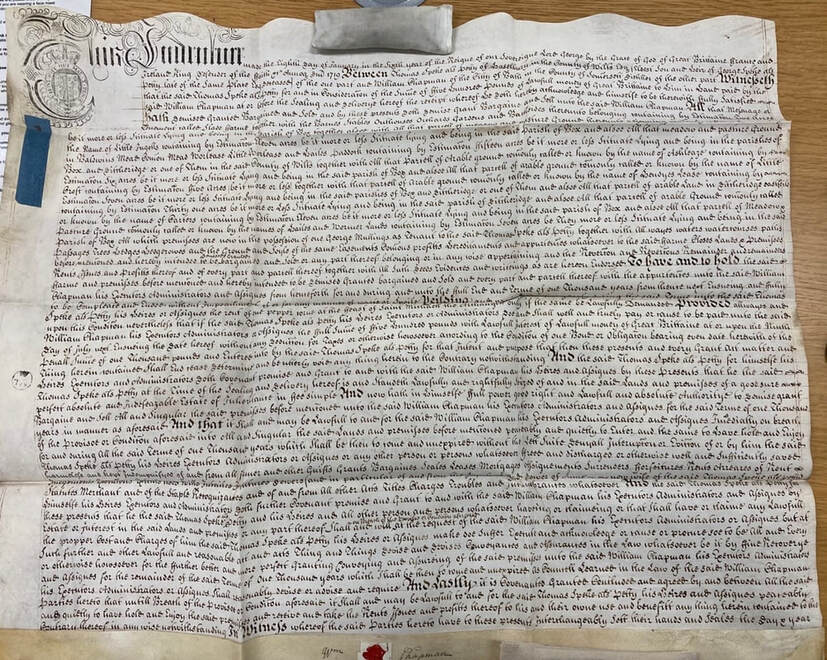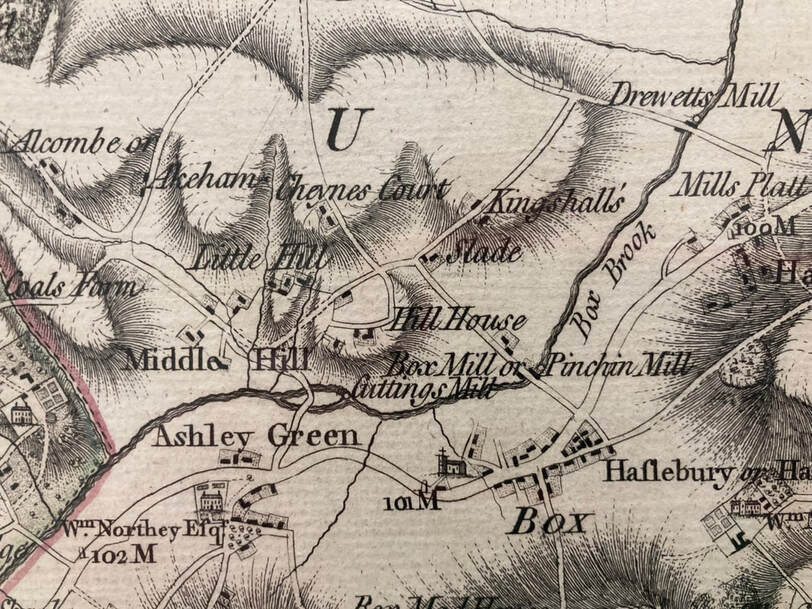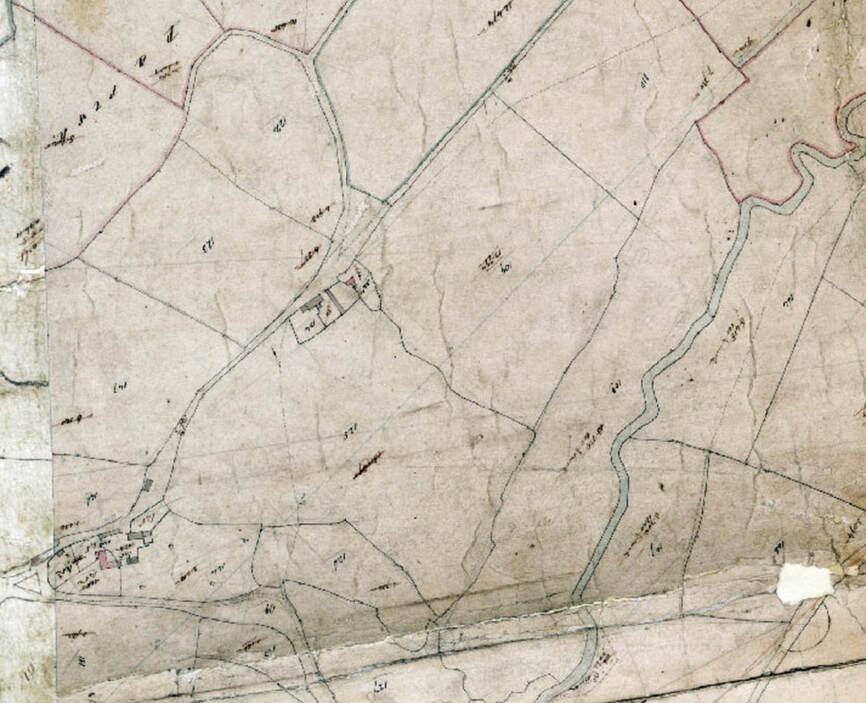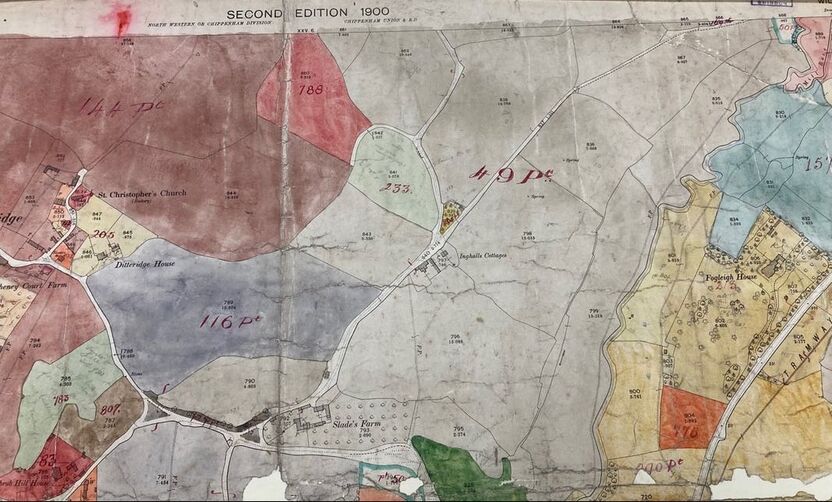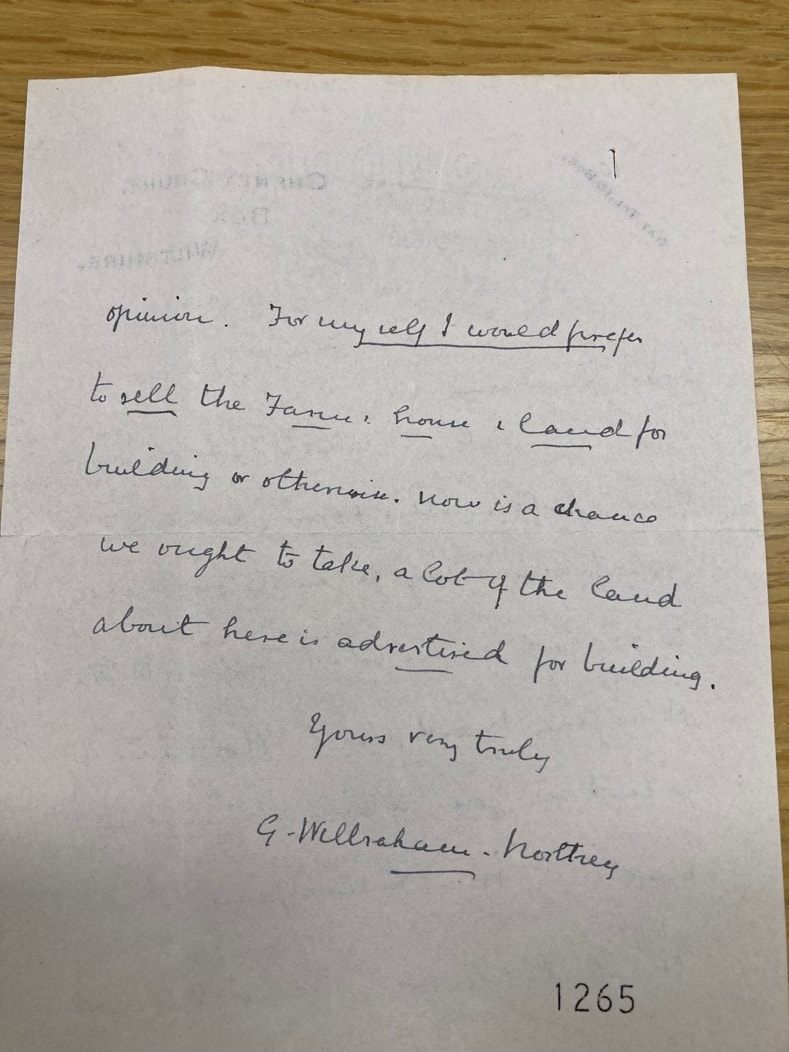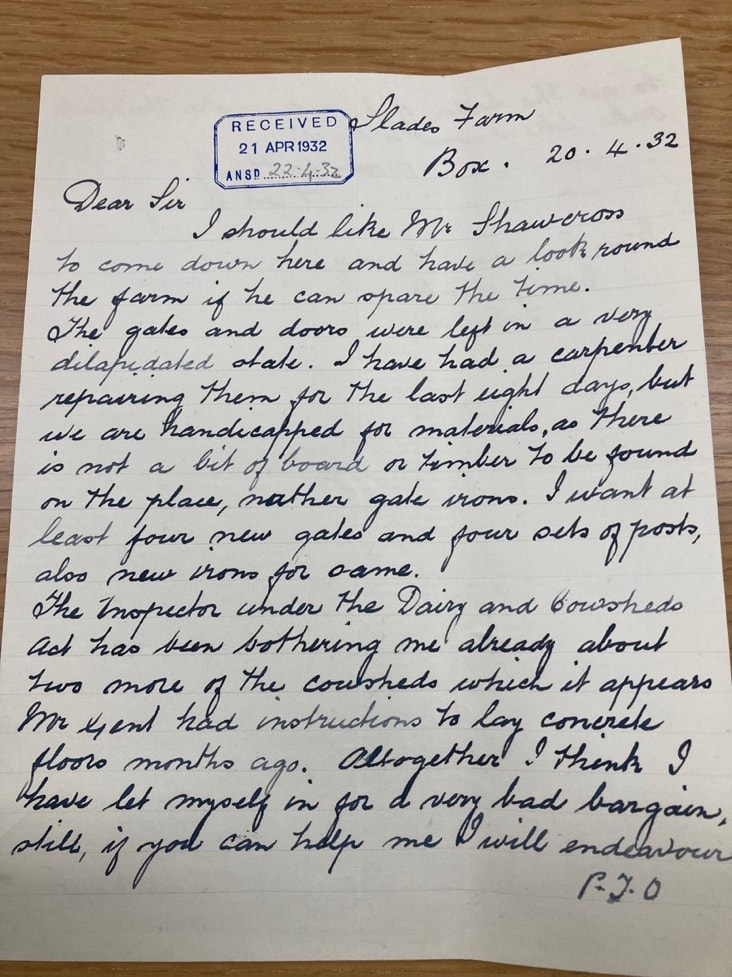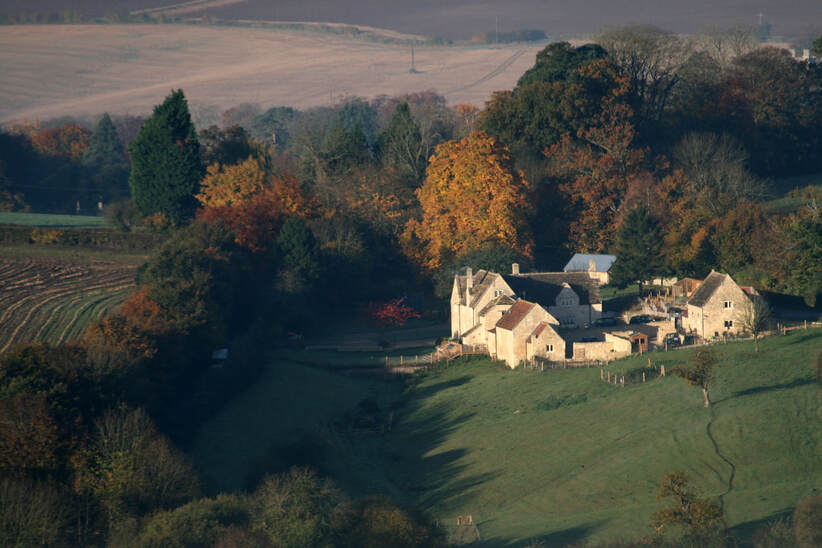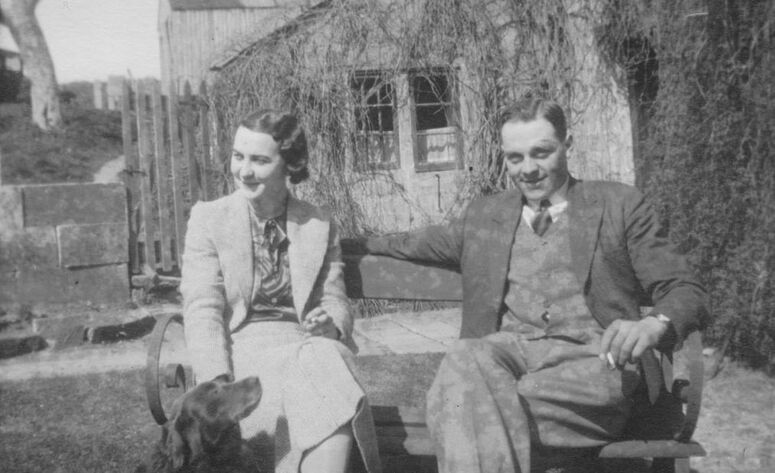Slades Farm Claire Dimond Mills March 2022
One of the oldest settlements in Box is Slades Farm situated overlooking the Bybrook stream. The road that runs in front of the farm dates to the Saxon times and went from the Fosse Way near Colerne to Pickwick and on to London. The farm has two sites, the main farmhouse and accompanying buildings on the road from Box to Ditteridge and then, further along the old Saxon road, Inghalls Cottages and the main farm buildings. Slade in old English means low lying ground, near a valley or slope of a hill, so the name of the farm is therefore self-explanatory!
Historic England makes references to two buildings on the site, the farmhouse dated to the early 17th Century, and the threshing barn, which has been dated to the 18th Century. Both buildings are made from rubble stone with stone tiled rooves. The early 17th Century date for the farm ties in with the Allen maps of 1626, which shows buildings at both Slades House and Inghalls (circled).
Historic England makes references to two buildings on the site, the farmhouse dated to the early 17th Century, and the threshing barn, which has been dated to the 18th Century. Both buildings are made from rubble stone with stone tiled rooves. The early 17th Century date for the farm ties in with the Allen maps of 1626, which shows buildings at both Slades House and Inghalls (circled).
However, local Norman historian Jane Cox thinks the site dates even further back to medieval times. On other maps Inghalls is sometimes called Kingshalls, which may denote a building with links to royalty. Jane has found two documents from the 13th century that discuss the renting of a croft called kynggeshalle and pasture for 100 sheep in the manor of La Boxe by Reginal Syward from his brother Henry Sampsonis de la Boxe, a member of the Bigod family who owned the manor of Box in the early Medieval period.[1] Jane thinks this croft called Kynggeshalle was likely to be a large barn used as a hall or house by the family. She thinks the foundations of this barn are probably underneath the main 18th century threshing barn and there are stones in the current barn that have possible medieval markings (one pictured) that were probably reused from the original Norman barn.
With the Saxon road running in front of the proposed site of the kings hall, the evidence certainly suggests this could be possible which means the farm would be one of the earliest known settlements in the area.
Slades Farm in 1719
The oldest document relating to the farm in the Wiltshire archives is a 1719 indenture (above). The document tells us that the owner of the farm was Thomas Speke, who was agreeing to lease the property to William Chapman of Bath, distiller, for £500 on a period of 1000 years. The farm included a messuage (house), tenements, barns, stables, outhouses, orchards, gardens and fields (many named on the 1626 map and still used today), as well as all ways, waters, paths, passages, trees, hedges and hedgerows.
In 1719 the farm was in the possession of George Mullings, tenant, descendants of whom were schoolmasters and vicars, who built Springfield House. This George Mullings may have been baptised on 19 December 1667 in Colerne which made him 52 in 1719. George was buried at Box on 10 December 1733 and in his will dated 20 November 1733, he made specific bequests totalling £111 to members of his family together with all household goods and implements and cattle, sheep, corn, hay etc.[2] This may imply that he was still at Slades Farm at the time of his death.
The oldest document relating to the farm in the Wiltshire archives is a 1719 indenture (above). The document tells us that the owner of the farm was Thomas Speke, who was agreeing to lease the property to William Chapman of Bath, distiller, for £500 on a period of 1000 years. The farm included a messuage (house), tenements, barns, stables, outhouses, orchards, gardens and fields (many named on the 1626 map and still used today), as well as all ways, waters, paths, passages, trees, hedges and hedgerows.
In 1719 the farm was in the possession of George Mullings, tenant, descendants of whom were schoolmasters and vicars, who built Springfield House. This George Mullings may have been baptised on 19 December 1667 in Colerne which made him 52 in 1719. George was buried at Box on 10 December 1733 and in his will dated 20 November 1733, he made specific bequests totalling £111 to members of his family together with all household goods and implements and cattle, sheep, corn, hay etc.[2] This may imply that he was still at Slades Farm at the time of his death.
The next piece of information we have is the 1773 Andrew’s and Drury map. This does not give us information about owners and tenants but does show the name of Kingshall’s for the site now known as Inghalls and suggests it was still known as Kingshall’s at this time.
The 1836 Tithe Map
The Speke family sold the manor of Box to the Northey family and by 1836, when the tithe apportionment act was enforced, Slades Farm was owned by Edward Richard Northey and William Brook Northey, and tenanted by John Olman. The farm was bigger than it is today but almost all the fields that make up the farm now were part of the farm then.
John Olman was born about 1773 not in Wiltshire and he married Susannah White from Overstowey on 28 April 1810. He was a widower when he married, his first wife Ann had died aged 35 and was buried in Ditteridge churchyard.
Living with John and Susannah Olman in 1841 was Susannah’s nephew Thomas White. John Olman died in 1846 at Slades Farm with 16 years left on his lease. John and Susannah did not have any children and Susannah and her nephew Thomas White appear to have taken over the remains of the lease. According to Kelley’s Directories Thomas White remained as farmer at Slades Farm until 1879, when he died aged 67, with his wife Jane White named as farmer until 1885. Thomas had married Jane Tyley in Box on 10 April 1849 and together they had at least five children including John Olman, William and Jane Elizabeth.
Brownings at the Farm
On 5 November 1884, Jane Elizabeth White married Walter Browning, one of the sons of their neighbours John and Sarah Browning who were millers at Drewett’s Mill. The Brownings were a huge and very important family in Box at this time. Walter and his older brother John took over at Drewett’s Mill from their father when he died in 1867 and also acquired Box Mill, running it as a flour mill.[3] It was Walter Browning who was named as the farmer at Slades Farm and both brothers were still living there in 1891, described as living on own means which suggests they were not working on the farm but living off their inheritance. Their mother, Jane White, died in 1888.
In addition to farmer and miller, Walter Browning was appointed to the newly-formed Box Schools management committee in 1903, which had taken over from the churchwardens as supervisors of the school. Their role was very hands on appointing staff, deciding school holidays, giving permission for students to leave school and repairing the premises.[4] He must have been a very busy man!
Walter and Jane had four children: Lilian, Alice, James White and Ethel. The family were still at Slades Farm in 1901 but by 1911 Jane, the children and her brothers had moved to Box Mill House after Walter had died on 31 May 1908, aged only 53. He left Jane £9,165 (in today’s money about £1.2million). Jane ran the flour mill along with her son James and daughter Alice until she died in 1924. Her other daughter Lilian, who was named as an art student in 1911, continued to run the mill until 1937.[5]
Richard Gent
The next tenant of Slades Farm was Richard Gent, Walter Browning’s brother-in-law, having married Walter’s sister Ellen Browning on 15 December 1897 at Box Church.
We know from the 1911 census that Richard was born in Bishops Lydeard, near Taunton, and at the time of his marriage he was a farmer at Colerne. By 1901 he had moved to Pockeridge Farm, in Hudswell with his wife Ellen and two daughters. Perhaps when Walter died, his brother-in-law offered to move to Slades Farm as he was there in 1911 with Ellen and their four children plus servant Grace Humphries.
Between 1910 and 1915 there was a nationwide land survey undertaken by the Valuation Office to find out how much land was worth and to ensure the correct tax was being paid. This gives us a wonderful snapshot of land ownership just before the First World War. This is the map of Slades Farm shows the field layout as almost identical to today.
The Speke family sold the manor of Box to the Northey family and by 1836, when the tithe apportionment act was enforced, Slades Farm was owned by Edward Richard Northey and William Brook Northey, and tenanted by John Olman. The farm was bigger than it is today but almost all the fields that make up the farm now were part of the farm then.
John Olman was born about 1773 not in Wiltshire and he married Susannah White from Overstowey on 28 April 1810. He was a widower when he married, his first wife Ann had died aged 35 and was buried in Ditteridge churchyard.
Living with John and Susannah Olman in 1841 was Susannah’s nephew Thomas White. John Olman died in 1846 at Slades Farm with 16 years left on his lease. John and Susannah did not have any children and Susannah and her nephew Thomas White appear to have taken over the remains of the lease. According to Kelley’s Directories Thomas White remained as farmer at Slades Farm until 1879, when he died aged 67, with his wife Jane White named as farmer until 1885. Thomas had married Jane Tyley in Box on 10 April 1849 and together they had at least five children including John Olman, William and Jane Elizabeth.
Brownings at the Farm
On 5 November 1884, Jane Elizabeth White married Walter Browning, one of the sons of their neighbours John and Sarah Browning who were millers at Drewett’s Mill. The Brownings were a huge and very important family in Box at this time. Walter and his older brother John took over at Drewett’s Mill from their father when he died in 1867 and also acquired Box Mill, running it as a flour mill.[3] It was Walter Browning who was named as the farmer at Slades Farm and both brothers were still living there in 1891, described as living on own means which suggests they were not working on the farm but living off their inheritance. Their mother, Jane White, died in 1888.
In addition to farmer and miller, Walter Browning was appointed to the newly-formed Box Schools management committee in 1903, which had taken over from the churchwardens as supervisors of the school. Their role was very hands on appointing staff, deciding school holidays, giving permission for students to leave school and repairing the premises.[4] He must have been a very busy man!
Walter and Jane had four children: Lilian, Alice, James White and Ethel. The family were still at Slades Farm in 1901 but by 1911 Jane, the children and her brothers had moved to Box Mill House after Walter had died on 31 May 1908, aged only 53. He left Jane £9,165 (in today’s money about £1.2million). Jane ran the flour mill along with her son James and daughter Alice until she died in 1924. Her other daughter Lilian, who was named as an art student in 1911, continued to run the mill until 1937.[5]
Richard Gent
The next tenant of Slades Farm was Richard Gent, Walter Browning’s brother-in-law, having married Walter’s sister Ellen Browning on 15 December 1897 at Box Church.
We know from the 1911 census that Richard was born in Bishops Lydeard, near Taunton, and at the time of his marriage he was a farmer at Colerne. By 1901 he had moved to Pockeridge Farm, in Hudswell with his wife Ellen and two daughters. Perhaps when Walter died, his brother-in-law offered to move to Slades Farm as he was there in 1911 with Ellen and their four children plus servant Grace Humphries.
Between 1910 and 1915 there was a nationwide land survey undertaken by the Valuation Office to find out how much land was worth and to ensure the correct tax was being paid. This gives us a wonderful snapshot of land ownership just before the First World War. This is the map of Slades Farm shows the field layout as almost identical to today.
Part of plot 49 (shown grey) were fields rented by Richard Gent. Plot 788 (coloured red) was in the possession of George Edward Northey, who still owned Slades Farm. Plot 233 was tenanted by Sarah Ponting who owned Pontings shop on the Market Place. The Goulstones at Hill House Farm (now Jamie’s Farm) had field 116 and the large burgundy area, 144, was farmed by Edwin Hobbs at Cheney Court Farm.
We do not know much about Richard and his wife Ellen Gent but their daughter Nellie Gent, along with three of her cousins, Ethel Browning, Amy Browning and Nellie Perren, and neighbour Dorothy Goulstone were part of the Voluntary Aid Detachment (VAD) Wilts 56 Box during World War 1. The VAD nurses worked at Corsham Town Hall when it was a WW1 hospital.[6] There is a plaque in their honour in the Town Hall.
We do not know much about Richard and his wife Ellen Gent but their daughter Nellie Gent, along with three of her cousins, Ethel Browning, Amy Browning and Nellie Perren, and neighbour Dorothy Goulstone were part of the Voluntary Aid Detachment (VAD) Wilts 56 Box during World War 1. The VAD nurses worked at Corsham Town Hall when it was a WW1 hospital.[6] There is a plaque in their honour in the Town Hall.
Handover from Gent to Ody
The Gents were at Slades Farm until 1932 when they moved to a bigger farm in Tormarton. The Wiltshire archives has several letters pertaining to the handover from Richard Gent to the next tenant Fred Ody, who had been renting a farm at Draycot and wanted to take on Slades Farm on behalf of his son.
George Northey wanted to sell the farm as you can see from this letter to his solicitor, saying I would prefer to sell the Farm, house and land for building. By 1932 he had sold almost all his buildings and land in Box, only Hill House Farm, Slades Farm and Cheney Court were still in his possession. He had witnessed the increased building of council houses at Barn Piece and the Ley at this time and he saw an opportunity to sell Slades Farm for housing. Someone must have convinced him to not sell, perhaps the ease in which Gent found a new tenant persuaded him renting out the farm was easier.
The Gents were at Slades Farm until 1932 when they moved to a bigger farm in Tormarton. The Wiltshire archives has several letters pertaining to the handover from Richard Gent to the next tenant Fred Ody, who had been renting a farm at Draycot and wanted to take on Slades Farm on behalf of his son.
George Northey wanted to sell the farm as you can see from this letter to his solicitor, saying I would prefer to sell the Farm, house and land for building. By 1932 he had sold almost all his buildings and land in Box, only Hill House Farm, Slades Farm and Cheney Court were still in his possession. He had witnessed the increased building of council houses at Barn Piece and the Ley at this time and he saw an opportunity to sell Slades Farm for housing. Someone must have convinced him to not sell, perhaps the ease in which Gent found a new tenant persuaded him renting out the farm was easier.
Correspondence over repairs to the farm in the 1930s (courtesy Wilts History Centre)
It seems, from a number of letters in the archives, that the farm was in a considerable state of disrepair and dilapidation and Fred Ody was keen that George Northey should contribute to the necessary repairs. However, Northey’s solicitors refused to help stating that Fred had signed a full repairing agreement. There was some back and forth as Fred was not very happy with Northey’s refusal to help financially. There does not seem to be a letter explaining the outcome but certainly not a very auspicious start!
Things got worse when a few months later when on 29 September 1932, Fred Ody died. Fred had married twice, the first time being to Cecilia Bryant in 1897. They had no children, and she died in 1906. In 1913 Fred married Lucy Bull and they had three children: George Matthew (often known as Peter) in 1913, Kenneth John in 1915, Marjorie Catherine in 1918.
Things got worse when a few months later when on 29 September 1932, Fred Ody died. Fred had married twice, the first time being to Cecilia Bryant in 1897. They had no children, and she died in 1906. In 1913 Fred married Lucy Bull and they had three children: George Matthew (often known as Peter) in 1913, Kenneth John in 1915, Marjorie Catherine in 1918.
Before George Ody married, he was living at Slades Farm with his mother Lucy and sister Marjorie. In 1940 George married Josephine Gifford. Her parents were Alexander and Annie Gifford who farmed at Manor Farm, Colerne. Their oldest child Gwendolen married Robert Best in 1921 and in 1939 were living on Bannerdown Road in a house called Rodmead in Batheaston. Also living with them were their two children, Peter Best born in 1924 and Richard Best born in 1929.
There are some charming memories of the Slades Farm with George (Peter) and Jo Ody during World War 2. One lady Joan Davis was billeted there when she served as a WAAF working out of Rudloe Manor. She and others remember the nephew Peter Best working there as a young lad.
There are some charming memories of the Slades Farm with George (Peter) and Jo Ody during World War 2. One lady Joan Davis was billeted there when she served as a WAAF working out of Rudloe Manor. She and others remember the nephew Peter Best working there as a young lad.
George Northey sold Slades Farm to the Odys in 1964, the last of their Box land to be sold. George (Peter) and Jo Ody did not have any children and, when Peter died on 18 March 1978, he left the farm to his nephew Peter Best and Peter’s son John.
The Best family continue to farm at Slades Farm today.
The Best family continue to farm at Slades Farm today.
References
[1] The Norman Conquest of Box, Wiltshire – Our Medieval Lords by Jane Cox. 2016
[2] http://www.boxpeopleandplaces.co.uk/mullins-family-schoolmasters.html
[3] http://www.boxpeopleandplaces.co.uk/box-mill.html
[4] http://www.boxpeopleandplaces.co.uk/formation-of-box-schools.html
[5] http://www.boxpeopleandplaces.co.uk/box-mill.html
[6] http://www.boxpeopleandplaces.co.uk/in-memoriam.html
[1] The Norman Conquest of Box, Wiltshire – Our Medieval Lords by Jane Cox. 2016
[2] http://www.boxpeopleandplaces.co.uk/mullins-family-schoolmasters.html
[3] http://www.boxpeopleandplaces.co.uk/box-mill.html
[4] http://www.boxpeopleandplaces.co.uk/formation-of-box-schools.html
[5] http://www.boxpeopleandplaces.co.uk/box-mill.html
[6] http://www.boxpeopleandplaces.co.uk/in-memoriam.html
